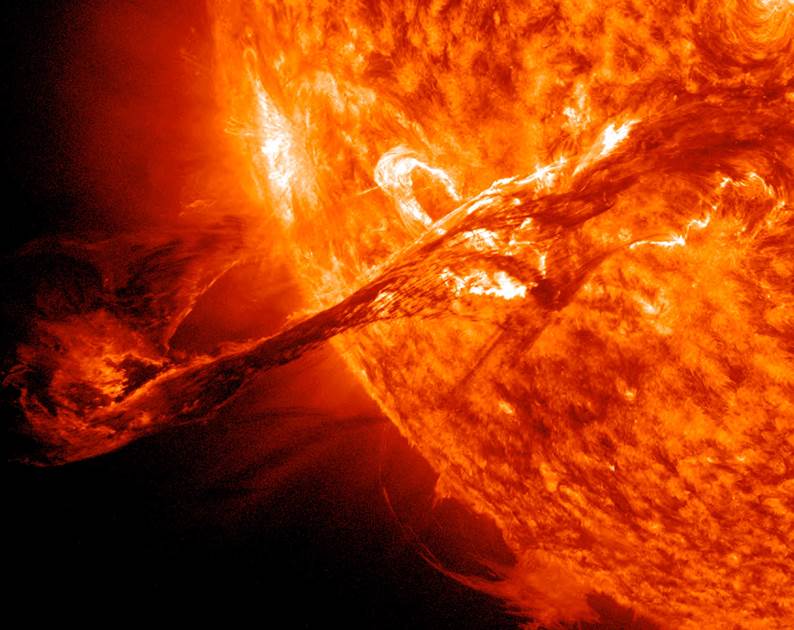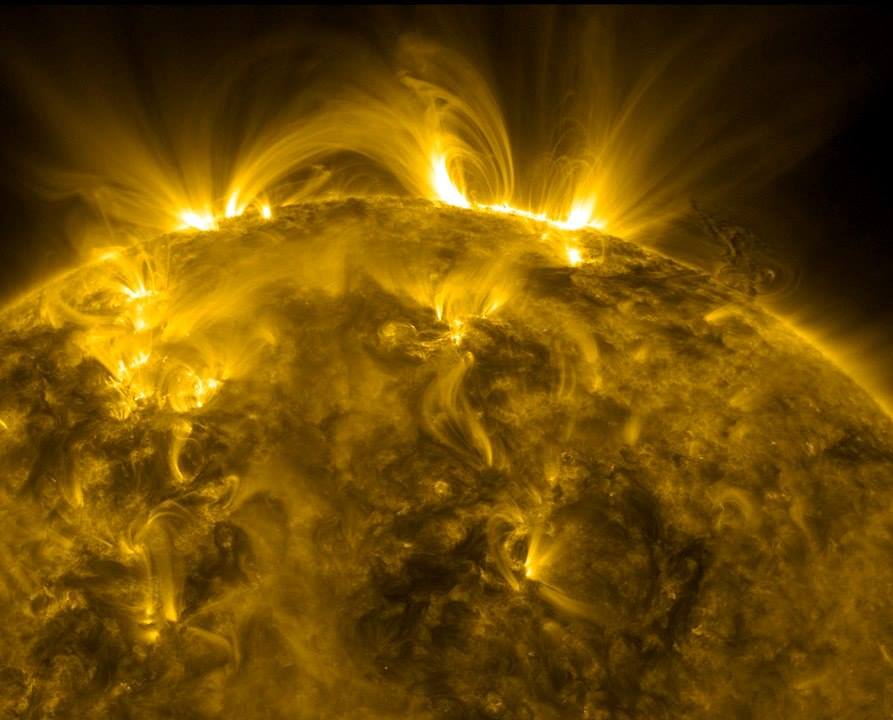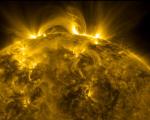How space weather forecasting could help Australia ride out future solar storms
05 October 2015
A training exercise brought the Bureau together with government and industry groups to devise a coordinated response to a hypothetical emergency: the worst solar storm in 150 years. The results chart the way to better planning and greater preparation, which could make all the difference in weathering the storm.
EXERCISE EXERCISE EXERCISE
‘URGENT WARNING TO ALL AUSTRALIAN RESIDENTS—an X42 solar flare has just been observed on the surface of the sun, of a magnitude not witnessed since the Carrington Event of 1859. This has resulted in very high-energy particles bombarding the near-Earth space environment, creating difficulties with satellite operations and hazardous radiation at aviation altitudes.
'A fast-moving coronal mass ejection is now travelling towards Earth at speeds of more than 2500 km per second. This will impact the Earth’s outer atmosphere at approximately 0800 hours tomorrow, producing a geomagnetic storm of extreme magnitude which could have impacts on power networks and precision navigation systems. GNSS systems will be unreliable and may cease to function, satellite communications may be interrupted, and electricity networks possibly disrupted.
'PS—Don’t panic … this is just a training exercise.'
This apocalyptic vision was the scenario for the latest 'cross-sectoral desktop exercise on hazard mitigation for critical infrastructure'—an event staged annually by the Trusted Information Sharing Network (TISN) of the Commonwealth Government’s Attorney-General’s Department. This unique networking event brings together business and government leaders to explore and evaluate responses to a hypothetical 'multi-sector disruption event' with major consequences for national critical infrastructure and implications for communities across Australia.
With senior managers and analysts from across the energy, transport, communications, water, finance, food and health sectors, the TISN for Critical Infrastructure Resilience provides a rare platform for sharing information and expertise that could prove vital to the long-term security of our most important infrastructure and essential services.
Today, Australia's critical infrastructure is more interlinked than ever before. The continuity of supply from each service provider usually depends on the availability of several other critical infrastructure services. Across the country, the degree and complexity of these linkages are increasing as we become ever more reliant on shared information systems and convergent communications technologies, such as the internet.
'The once-in-a-century space weather event scenario provided an excellent opportunity for industry and government to examine their close cross-sectoral dependencies, as such an event could impact on the operations of a variety of sectors all at the same time,' explains Richard Marshall of the Bureau’s Space Weather Services section. Richard has been working with electricity companies and other industry groups to improve their capacity to manage severe space weather events.
'As such an event would be likely to have a wide impact geographically, this scenario was also valuable in highlighting issues around the governance of managing a national-scale disaster—between Federal and State agencies, State-to-State, and down to the municipal level.'
For many of the industry representatives present, the event provided a timely reminder of the importance of including severe space weather in their business continuity planning, as well as highlighting their reliance on other infrastructure sectors that may not be so well prepared. For the Bureau, it was a particularly significant event—raising the profile of the agency’s space weather warning services, and highlighting the potential for more sector-focused warnings for specific hazard events.
'Space weather and satellites are not something we think about in our day-to-day business,' said one of the participants. 'This exercise really brought home the importance of sharing information and having clear lines of communication with the right people in other sectors. We also need to make sure we are prepared and know what to do if we are going to lose satellite communications.'
The choice of a severe space weather event for the TISN exercise became even more pertinent on June 21, when a long-duration solar flare produced an Earth-directed coronal mass ejection (CME)—leading the Bureau to issue its first 'severe space weather watch' since the service began in March 2013. The CME's impact early in the morning of 23 June led to some spectacular auroras, but the storm activity fell short of the anticipated 'severe' threshold by about 5 per cent.
'Severe-to-extreme space weather has been placed on the national risk register in the UK and is taken seriously as a possible threat to critical infrastructure in the US,' says Richard Marshall. 'Extreme space weather is increasingly being considered a natural hazard along with better-known phenomena, such as cyclones, tsunamis, earthquakes and floods.'
What is space weather?
The term 'space weather' refers to events beyond the Earth's atmosphere that impact upon our technology and the near-Earth space environment. The primary source of space weather is the sun, with the greatest disturbances usually caused by solar flares and subsequent geomagnetic storms. These could potentially:
- jam radio waves, affecting telecommunications;
- damage satellites, or render them non-functional as operators 'hibernate' them to protect them from harm;
- overload power circuits, causing a risk to supply and infrastructure;
- make global navigation satellite systems (GNSS) signals unreliable; and
- increase harmful solar radiation, with possible risks to health at aviation altitudes.
Other solar features such as coronal holes and disappearing solar filaments can also have impacts on the near-Earth space environment—although these are generally not as significant as the geomagnetic storms generated by large solar flares.
Since the dawn of the 'Space Age' in the late 1950s, we have become increasingly susceptible to space weather as we have grown more reliant on electrical grids, satellite navigation, and radio and wireless communications. But while there have been a number of severe space weather events during this period, it is generally considered that modern technology is yet to experience a 'once-in-a-century' or more extreme space weather event.
The benchmark for such an event is typically referred to as the Carrington Event, after English astronomer Richard Carrington, who first observed and reported an extreme solar flare on 1–2 September 1859. The geomagnetic storm that followed has been estimated to be a number of times larger, on the geomagnetic storm-time index, than any other such event in the Space Age.
The impacts of the Carrington Event have been widely documented and analysed. It was said that this 'solar superstorm' produced auroras so powerful that people in the northeast United States could read newspapers by their light. Across the entire northern hemisphere, massive electrical currents surged through telegraph lines and caused sparks to leap from telegraph poles. Even when telegraph operators disconnected the batteries powering the lines, aurora-induced currents in the wires allowed messages to be transmitted.
There have been several smaller solar storms in more recent times. In 1989, the Canadian province of Quebec suffered a nine-hour blackout due to a solar storm, while in October 2003, a major geomagnetic storm led to the damage of 14 large electrical transformers in South Africa.
Australian society is also increasingly reliant on precision navigation and timing systems which are vulnerable to space weather. Extreme space storms have the capacity to disrupt—if not render unworkable—precision landing systems and GNSS. Many of the larger satellite operators can place their satellites into 'safe mode'—this can save their hardware but is likely to result in loss of data.

A solar filament structure many times the size of Earth erupts following a solar flare, carrying magnetised plasma into space. Plasma clouds, or coronal mass ejections (CMEs), cause geomagnetic and ionospheric storms (Image courtesy of NASA).
Preparing for a 'perfect space storm'
In recent years, there have been increasing efforts to understand the possible risks to infrastructure posed by low-frequency, high-impact solar events, and advances in how best to mitigate them.
Although the various space weather phenomena discussed above have widely varying intensities and lead times, governments and national space weather agencies can prepare for the worst-case scenario, such as the TISN exercise, in which a 'perfect space storm' could potentially deliver all of these impacts simultaneously.
As well as the impacts on power supplies and satellite communications, recent research points to a number of lesser-known potential impacts from the intense bursts of magnetic energy and solar radiation associated with solar storms. Several could have cost implications for Australian industry—from reduced accuracy of mine drilling equipment and corrosion caused by electrical currents in long-distance metal pipelines, to elevated radiation risks for aircraft crew and interruptions of wireless communications.
Many businesses are now taking steps to protect their operations in the case of a severe space weather event. In industries such as aviation and banking, far-sighted companies are diversifying their communications systems—adding technologies such as fibre-optics and undersea cables to their satellite and wireless networks—to limit their exposure to space weather. Others are appointing 'space-savvy' engineers and adopting real-time monitoring systems that provide early warnings of changes in solar weather patterns.
Some power distributors have installed special capacitors that can block currents induced by space weather, while major banks and mobile phone networks are adopting high-precision local clock systems that provide an alternative to Satnav and internet time services. Many large power companies, airlines, and mobile networks are developing 'space weather plans'. These enable them to implement changed business procedures to bypass and protect technologies likely to be affected during a space weather event.
The Bureau has been working with the Australian Energy Market Operator (AEMO), and transmission and distribution network service providers, to better understand and mitigate the impacts of a severe space weather event on the power system. After several years of investigation and collaboration, AEMO implemented procedures for the management of severe space weather geomagnetic storms. An integral part of these procedures is the issuing of a severe space weather event warning by the Bureau, which gives them up to 24 hours' notice to enact their plans.

Looping tubes of plasma (or 'solar prominence') are constrained by the sun's magnetic fields, but can be ejected into space when these become unstable (Image courtesy of NASA).
Space weather information for Australia
The Bureau provides space weather information and warning services to the Australian region and beyond. These are available 24/7 on its website. It is also working closely with industry sectors with operations exposed to space-weather risk—such as aviation, energy, defence and telecommunications—moving towards tailoring forecasts and warnings to their specific needs. The space weather advisory service focuses on forecasting and monitoring severe-to-extreme events that could be of threat to critical infrastructure. Like the Bureau's cyclone and other severe weather warning services, graded advisory notifications (e.g. 'Event watch', 'Event in progress') are issued when an event occurs on the sun with characteristics typical of previous events that have resulted in severe space weather.
Details of this service can be found at www.ips.gov.au/mailman/listinfo/ips-esws-general or under the Warnings section at www.ips.gov.au/Products_and_Services/4/1.


Comment. Tell us what you think of this article.
Share. Tell others.